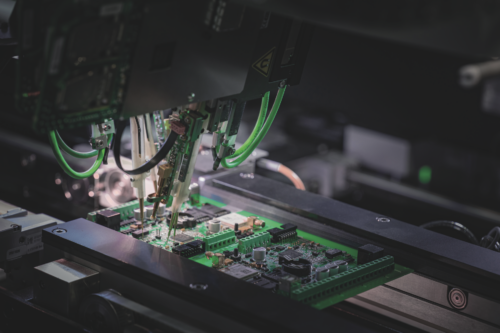The future belongs to those who can source and correctly implement the right components.
It may surprise you just how much you can accomplish with discrete semiconductors alone before you even bring hard drives, RAM, and logic chips into the picture. For instance, early pinball machines and arcade games like Whac-A-Mole relied entirely on discrete logic with no need for advanced computer components.
So, if you can build a whole arcade out of discrete semiconductors, there are endless possibilities when you add artificial intelligence (AI) and machine learning (ML) into the equation. In particular, AI’s ability to optimize performance opens up a whole new frontier in electrical engineering. At the most basic level, this means less power drain, less overheating, and more efficient electrical systems overall. The ripple effect is where things get interesting,as greater efficiency and less overheating pave the way for bigger, more complex, and more ambitious electrical systems.
Understanding the current landscape
Diodes, transistors, thyristors, and logic are all categorized as semiconductor devices. An LED, or light emitting diode, is another example of a semiconductor device. Laser diodes, thermal sensors, and magnetic sensors are also types of semiconductor devices. Once you break an electrical gadget down to its base components, you’re looking at a pile of discrete semiconductor devices. The challenge has always been simply getting the electrical power where it needs to go in the most efficient way possible. As the transmission of electricity from point A to point B becomes more efficient, the systems can become more sophisticated and new possibilities are facilitated.
To emphasize the importance of efficiency, consider the CDC 6600, which was the world’s fastest computer in the late 1960s. Measuring 79 inches tall, 165 inches wide, and 67 inches deep, this machine weighed in at around six tons. With all that, you had a performance power of three megaFLOPS. By comparison, a high-end smartphone today is capable of around 100 megaFLOPS.
At one time, discrete semiconductor logic boards were designed and built by hand. With advancements in computer technology, logic boards could be designed with the assistance of sophisticated computer programs based on known data. With AI, we can dig deeper into that data, checking it in real-time and allowing the software to make adjustments on the fly in ways that would be impossible without a complex algorithm in place to guide the process.
The integration of AI in semiconductor devices
One example of AI integration into semiconductor devices can be considered at a manufacturing level: automatic defect detection. Manual inspections of discrete semiconductor boards are time-consuming and prone to human error. Automatic defect detection will let manufacturers know in a microsecond if a discrete semiconductor
is malfunctioning.
The most important function of AI integration is data generation. At present, AI generates around 80 exabytes of data per year. This is expected to increase tenfold over the next year or two. The data collected from semiconductor components can be incorporated into those components’ behavior in real-time. For example, if an LED is drawing too much power, this can be fine-tuned on the fly with no input from the user. Another term for machine learning is statistical learning. When you misspell a word and the search engine makes an educated guess at what you were trying to type, that’s a product of statistical learning. What we call artificial intelligence largely comes down to a game of statistical probability.
In principle, what a machine learning algorithm does is no different from what a pinball programmer with a soldering iron did almost a hundred years ago (the firstpinball machines appeared in the early 1930s). The pinball programmer relied on his years of experience to identify redundancies and look for the shortest path from point A to point B to lower production costs and create a more efficient product. The algorithm is just doing the same thing at several million times the speed.
Challenges and considerations for design engineers
Machine learning is a tremendous boon for design engineers, but getting to the next stage won’t be easy. There are effectively three major hurdles standing in the way in the categories of implementation, compatibility, and scalability.
First, simply building new electrical systems around AI-capable hardware will be a challenge in itself. Second, manufacturers need to find suppliers who understand and can provide semiconductor devices that are compatible with AI-enabled hardware. Finally, as demand for these components increases, it is unlikely that supply will be able to keep pace in the immediate future.
Add to all of this that the industry is still recovering from pandemic-era shortages and supply-chain breakdowns, and you have a lot of speed bumps between design engineering as it is and as it could be.
As is often the case in any area of production or manufacturing, the strategies to overcome these challenges are mostly logistical in nature. If you have partners who can connect you to the parts you need and show you how they’re best implemented, this can help carry you over the hurdles slowing down the rest of the industry.
Mapping the future
The shift toward AI- empowered electrical systems and computer hardware is not only exciting, but also inevitable. Put simply, consumers will vote with their wallets. When one smartphone is cheaper, smaller, and more powerful than another, that’s the one the customer will buy, and that’s what machine learning will enable in everything from laptops and gaming consoles to amplifiers and EV chargers.
At TTI, we love a good challenge, and if helping to build the next era of electrical systems and computer technology isn’t a good challenge, then we don’t know what is. In the last year alone, we shipped more than 27 billion units thanks to our team of seasoned specialists and our network of suppliers, and we’re proud to offer tailor-made solutions to help our customers stay ahead of the curve in exciting but uncertain times.

